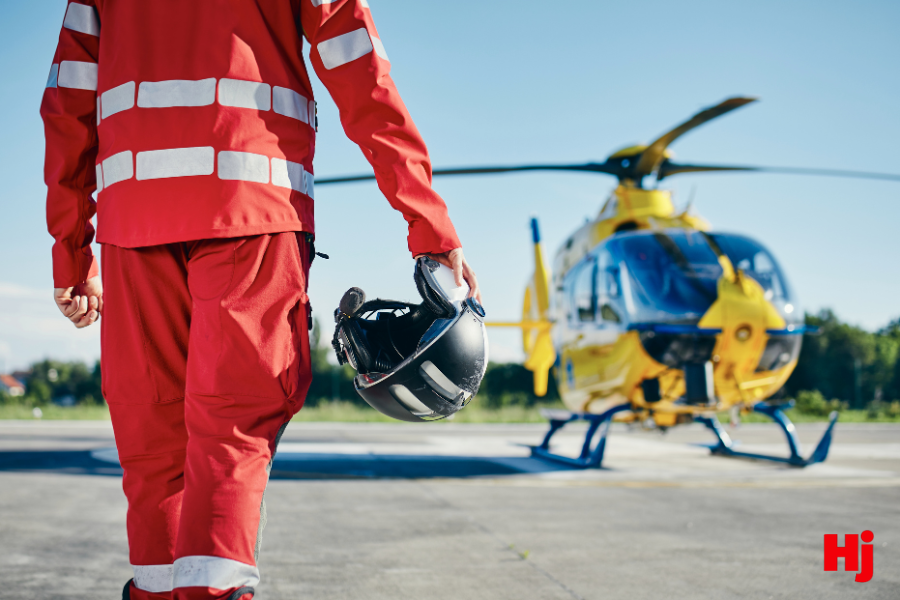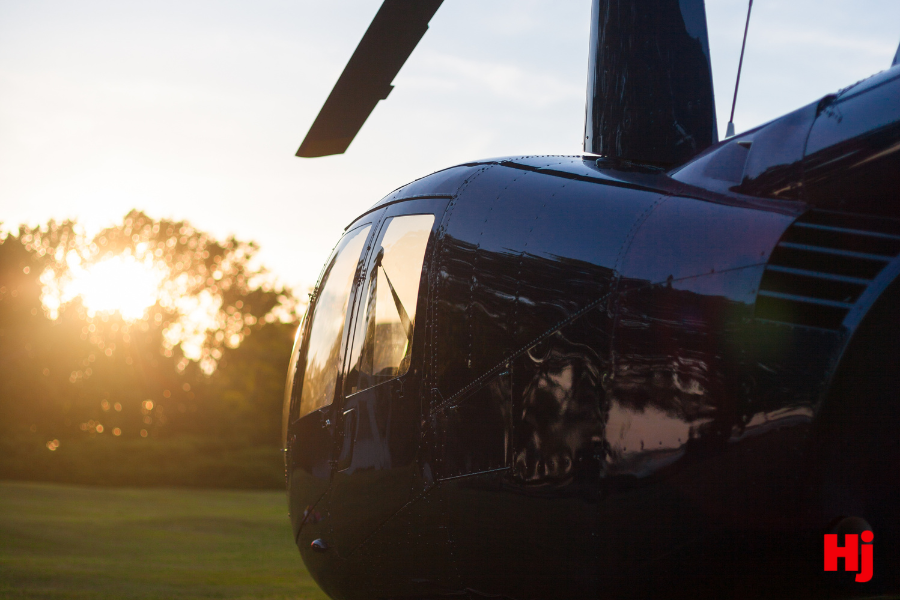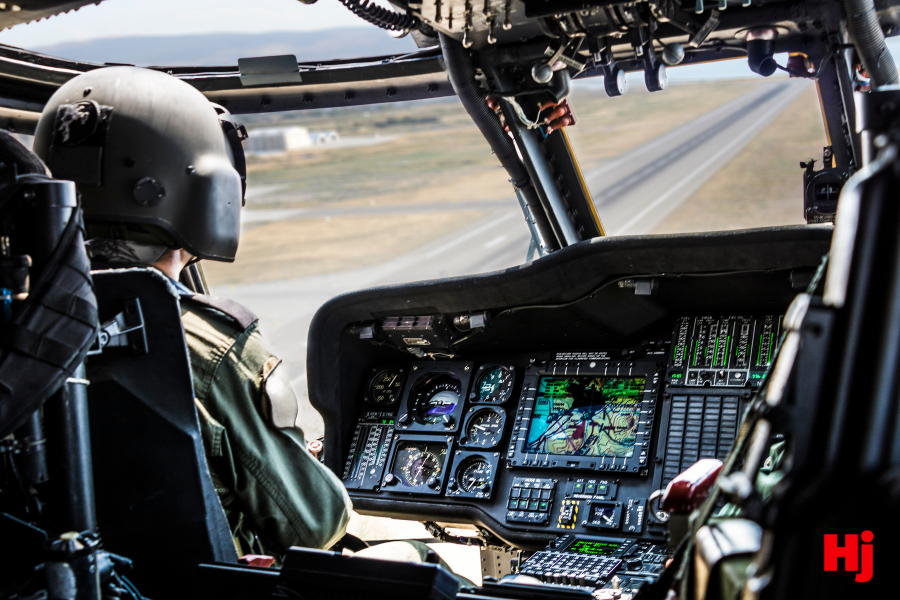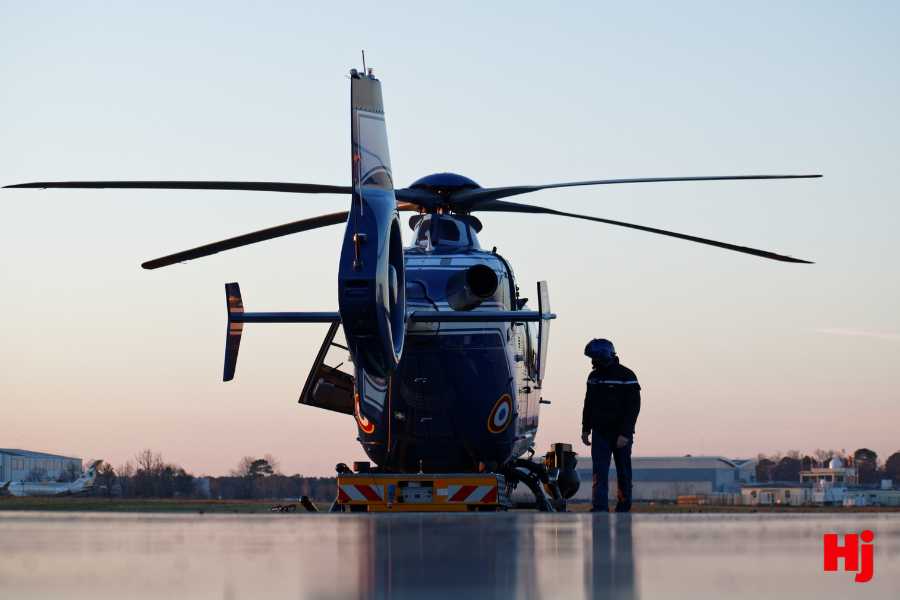Helicopter Pilot Career Series
(Part 1):
How to Become a Helicopter Pilot in 2025 - Training Guide, Licenses & Cost Breakdown
Becoming a helicopter pilot offers one of aviation's most diverse and rewarding career paths, with opportunities ranging from life-saving emergency medical services to scenic tourism flights. The helicopter industry is experiencing steady growth, with pilot demand projected to increase 6% through 2028. While the journey requires a significant investment—typically $50,000-$100,000 and 6 months to 2 years of training—helicopter pilots earn an average salary of $91,788, with experienced pilots in specialized roles earning $150,000+.
This comprehensive guide covers everything you need to know: licensing requirements, training costs, school selection, career paths, and actionable steps to launch your helicopter pilot career in 2025.

1. Understanding Helicopter Pilot Licenses
The FAA requires specific certifications for different levels of helicopter operation. Here's your step-by-step licensing pathway:
Student Pilot Certificate
- Minimum Age: 16 years old
- Purpose: Allows supervised flight training and eventual solo flights
- Requirements: Valid government-issued ID and FAA medical certificate
Private Pilot License (PPL) - Helicopter
- Minimum Age: 17 years old
- Flight Hours Required: Minimum 40 hours (most students need 50-60 hours)
- Allows: Personal flying, no compensation
- Key Training: Basic flight maneuvers, emergency procedures, navigation
Commercial Pilot License (CPL) - Helicopter
- Minimum Age: 18 years old
- Flight Hours Required: Minimum 150 hours total time
- Allows: Professional flying with compensation
- Key Training: Advanced maneuvers, complex aircraft operations, commercial operations
Airline Transport Pilot License (ATPL) - Helicopter
- Minimum Age: 23 years old
- Flight Hours Required: 1,200 hours total time
- Allows: Pilot-in-command for operations requiring ATP certificate
- Additional: First-class medical certificate (required to exercise the privilege's of an ATP)
Certified Flight Instructor (CFI) - Helicopter
- Requirements: Commercial license + additional training
- Benefits: Essential for building hours while earning income
- Typical Path: Most pilots become CFIs to build experience toward 1,000+ hour positions
2. Training Investment: Costs, Timeline, and Financing
Realistic Cost Breakdown
Private Pilot License (PPL)
- Ground school materials: $500-$1,000
- Medical certificate: $150-$400
- Written exam fee: $175
- Flight training (50-60 hours): $15,000-$22,000
- Checkride fees: $800-$1,200
- Total PPL Investment: $16,625-$24,775
Commercial Pilot License (Additional Costs)
- Advanced ground school: $800-$1,500
- Additional flight hours (90-110 hours): $25,000-$35,000
- Complex aircraft training: $2,000-$4,000
- Commercial checkride: $1,000-$1,500
- Additional Investment: $28,800-$42,000
Complete Zero-to-Commercial Investment: $45,425-$66,775
Important Note: These are minimum estimates. Most students spend $70,000-$90,000 for complete training due to additional hours needed, weather delays, and varying local costs.
Training Timeline Expectations
Full-Time Training (5-6 days/week)
- Private License: 3-5 months
- Commercial License: Additional 6-8 months
- Total Time: 9-13 months
Part-Time Training (2-3 days/week)
- Private License: 8-12 months
- Commercial License: Additional 12-18 months
- Total Time: 20-30 months
Factors Affecting Timeline
- Weather conditions and seasonal flying
- Aircraft availability and maintenance schedules
- Personal learning pace and consistency
- Instructor availability and school efficiency
Comprehensive Financing Options
Federal Financial Aid
- Pell Grants: Up to $7,395 per year for eligible students
- Federal Direct Loans: Up to $12,500 per year for undergraduates
- Parent PLUS Loans: Up to full cost of attendance
*Federal aid only applies if the school is accredited and Part 141 (e.g., university aviation programs). Most standalone helicopter schools (Part 61/141 without college tie-ins) don’t qualify for Pell or federal loans.
Veteran Benefits
- GI Bill: Covers significant training costs at VA-approved schools
- Yellow Ribbon Program: Additional funding at participating schools
- VR&E Benefits: Vocational rehabilitation for service-connected disabilities
*VA benefits apply at VA-approved Part 141 schools
Private Financing
- Sallie Mae Career Training Loans: Aviation-specific programs
- Stratus Finance: Specialized flight training loans with flexible terms
- AOPA Finance: Competitive rates for aviation students
- Meritize: Skills-based lending for career training
Alternative Funding Sources
- Helicopter Association International (HAI) scholarships
- Women in Aviation International scholarships
- Whirly-Girls International scholarships for women helicopter pilots
- Aircraft Owners and Pilots Association (AOPA) scholarships
- Employer tuition assistance programs
3. Choosing the Right Flight School
Essential Selection Criteria
1. Safety Record and Reputation
- FAA accident/incident history
- Insurance requirements and safety management systems
- Student and instructor testimonials
2. Accreditation and Approvals
- Part 141 vs Part 61: Part 141 offers structured curriculum, often fewer required hours
- VA Approval: Essential if using GI Bill benefits
- ACCSC Accreditation: Enables federal financial aid eligibility
3. Fleet and Equipment Quality
- Aircraft age, condition, and maintenance records
- Simulator availability for cost-effective training
- Modern avionics and safety equipment
4. Instructor Quality
- Experience levels and industry backgrounds
- Student-to-instructor ratios
- Instructor retention and continuity
5. Performance Metrics
- First-time checkride pass rates (should be 80%+)
- Average completion times
- Job placement assistance and success rates
School Comparison Questions
Before committing, ask each prospective school:
- What is your first-time checkride pass rate for the past two years?
- What is the total average cost for students completing commercial training?
- How many flight hours do most students actually require?
- What is your instructor retention rate and average tenure?
- Can you provide recent graduate contact information?
- What financing options are available?
- What is your aircraft availability and typical scheduling delays?
- What job placement services do you provide?
- Are there additional fees not included in quoted prices?
- What is your safety record and insurance coverage?

Top Helicopter Training Schools in the United States
Premier Training Academies
Hillsboro Aero Academy – Hillsboro, Oregon
Overview: One of America's most established helicopter training schools, attracting international students from 55+ countries.
Programs Offered:
- Private through Commercial pilot certifications
- Certified Flight Instructor (CFI) training
- Multi-engine helicopter transition courses
- Career placement assistance programs
Fleet: Modern Robinson R22 and R44 helicopters, flight simulators, on-site maintenance
Unique Advantages:
- Strong industry connections with major operators
- High graduation rates and job placement success
- Year-round flying weather in Oregon
- International student support services
Best For: Students seeking comprehensive programs with strong industry connections
Quantum Helicopters – Chandler, Arizona
Overview: Specializing in accelerated, intensive training programs in Arizona's ideal desert flying conditions.
Programs Offered:
- Fast-track Private to Commercial programs
- Flight instructor training
- Military transition programs
- Veteran-specific support services
Fleet: Robinson R22 and R44 helicopters, modern flight simulators
Unique Advantages:
- 300+ flying days per year due to desert climate
- Accelerated programs for focused, full-time students
- Small class sizes for personalized instruction
- Strong relationships with regional employers
Best For: Students who can commit to full-time, intensive training schedules
Leading Edge Flight Academy – Bend, Oregon
Overview: One of the country's largest and busiest helicopter flight schools, known for high-volume training and diverse program offerings.
Programs Offered:
- Private through Commercial and CFI certifications
- Night Vision Goggle (NVG) training
- Mountain flying and specialized environment training
- Turbine transition courses
Fleet: Large Robinson R22 and R44 fleet, advanced simulators, on-site maintenance
Unique Advantages:
- High annual flight hours indicate consistent training availability
- Mountain flying environment prepares pilots for challenging conditions
- Pathways to firefighting, utility, and EMS careers
- Comprehensive support services
Best For: Students seeking diverse training environments and specialized career preparation
University-Integrated Programs
Embry-Riddle Aeronautical University – Prescott, AZ & Daytona Beach, FL
Programs: Bachelor's degree in Aeronautical Science with helicopter concentration Advantages: Academic credentials plus pilot ratings, global aviation industry recognition Best For: Students seeking university education combined with flight training
Southern Utah University – Cedar City, Utah
Programs: Bachelor's degree in Aviation with rotorcraft emphasis Advantages: Largest collegiate helicopter fleet in the U.S., high-altitude mountain training Best For: Students wanting structured university program with extensive flight training
University of North Dakota – Grand Forks, North Dakota
Programs: Bachelor of Science in Aeronautics with helicopter concentration Advantages: Nationally recognized aerospace program, cold-weather operations experience Best For: Students seeking comprehensive aerospace education with helicopter specialization
Manufacturer Training Centers
Airbus Helicopters Training Services
- Multiple U.S. locations
- Type-specific training for H125, H130, H135, H145
- Advanced simulator training and mission-specific instruction
Leonardo Helicopters Training Academy
- Philadelphia, Pennsylvania
- AW139, AW109, AW169 helicopter training
- Manufacturer expertise with advanced systems training
Bell Flight Training
- Multiple locations
- Bell 206, 407, 429, 412 specialized training
- Focus on safety, avionics, and operational readiness
4. Building Your Helicopter Pilot Career
Entry-Level Career Paths (0-500 hours)
Certified Flight Instructor (CFI)
- Salary Range: $35,000-$50,000 annually
- Requirements: Commercial license + instructor rating
- Benefits: Build hours while earning income, develop teaching skills
- Career Impact: Essential stepping stone for most pilots
Pipeline/Powerline Patrol Pilot
- Salary Range: $45,000-$65,000 annually
- Requirements: 150-300 hours, commercial license
- Work: Monitor oil/gas pipelines and electrical infrastructure
- Benefits: Consistent schedules, good hour-building opportunity
Traffic Reporting Pilot
- Salary Range: $40,000-$55,000 annually
- Requirements: 150-500 hours, commercial license
- Work: Provide traffic updates for radio/TV stations
- Benefits: Regular schedules, urban flying experience
Agricultural Operations
- Salary Range: $40,000-$70,000 annually (seasonal)
- Requirements: 150-500 hours, specialized training
- Work: Cherry drying, surveys, livestock management
- Benefits: Diverse flying, good pay during season
Mid-Level Career Paths (500-1,500 hours)
Emergency Medical Services (EMS)
- Salary Range: $75,000-$120,000 annually
- Requirements: 1,000+ hours, instrument rating, specialized training
- Work: Critical care transport, search and rescue
- Benefits: High job satisfaction, excellent benefits, stable employment
Law Enforcement
- Salary Range: $70,000-$110,000 annually
- Requirements: 500-1,000 hours, law enforcement training
- Work: Patrol, search and rescue, surveillance, tactical operations
- Benefits: Government benefits, retirement plans, job security
Tourism/Scenic Flights
- Salary Range: $45,000-$80,000 annually
- Requirements: 300-1,000 hours, excellent communication skills
- Work: Sightseeing tours, charter flights
- Benefits: Scenic work environments, customer interaction
Utility/Construction
- Salary Range: $60,000-$95,000 annually
- Requirements: 500-1,000 hours, external load training
- Work: Power line construction, heavy lifting operations
- Benefits: Specialized skills, good pay, diverse projects
Advanced Career Paths (1,500+ hours)
Offshore Operations
- Salary Range: $100,000-$200,000+ annually
- Requirements: 1,500+ hours, instrument rating, offshore training
- Work: Oil platform support, offshore wind operations
- Benefits: Highest pay in industry, structured schedules
Corporate/VIP Transport
- Salary Range: $80,000-$150,000 annually
- Requirements: 1,000-2,000 hours, impeccable safety record
- Work: Executive transport, luxury charter services
- Benefits: High-end aircraft, excellent working conditions
Firefighting Operations
- Salary Range: $70,000-$130,000 annually (seasonal)
- Requirements: 1,000+ hours, specialized training
- Work: Wildfire suppression, water bucket operations
- Benefits: Meaningful work, excellent seasonal pay
Test Pilot/Government Operations
- Salary Range: $90,000-$200,000+ annually
- Requirements: Extensive experience, specialized training
- Work: Aircraft testing, military contracting, specialized missions
- Benefits: Cutting-edge technology, unique experiences
Geographic Career Considerations
High-Demand Regions:
- Gulf Coast: Offshore operations, oil and gas industry
- Western States: Firefighting, tourism, utility work
- Major Metropolitan Areas: EMS, law enforcement, corporate transport
- Alaska: Tourism, utility work, challenging environment operations
Seasonal Considerations:
- Summer: Peak firefighting and tourism seasons
- Year-Round: EMS, law enforcement, offshore operations
- Spring/Fall: Agricultural operations, utility maintenance
5. Medical Requirements and Health Considerations
FAA Medical Certificate Requirements
Third-Class Medical Certificate
- Required For: Private pilot operations
- Valid For: 5 years (under age 40), 2 years (over age 40)
- Examiner: FAA-authorized Aviation Medical Examiner (AME)
Second-Class Medical Certificate
- Required For: Commercial pilot operations
- Valid For: 1 year for commercial operations, then reverts to third-class privileges
- Standards: More stringent than third-class requirements
First-Class Medical Certificate
- Required For: Airline Transport Pilot operations
- Valid For: 6 months (over age 40), 1 year (under age 40)
- Standards: Most stringent medical requirements
Medical Examination Components
Physical Assessment:
- Vision testing (distant, near, color, field of vision)
- Hearing evaluation
- Blood pressure and pulse rate
- General physical examination
- Neurological assessment
Medical History Review:
- Previous surgeries and hospitalizations
- Current medications
- Mental health history
- Substance use history
- Cardiovascular history
Potentially Disqualifying Conditions
Automatically Disqualifying:
- Certain heart conditions
- Insulin-dependent diabetes
- Bipolar disorder
- Substance dependence
- Certain neurological conditions
May Require Special Issuance:
- Controlled diabetes (non-insulin dependent)
- Certain heart conditions with treatment
- Depression with treatment
- Sleep apnea with treatment
Important: Consult with an Aviation Medical Examiner early in your training process to identify and address any potential medical issues.
6. Industry Technology and Future Trends
Current Technology Impacting Training and Operations
Advanced Avionics:
- Glass cockpit displays becoming standard
- GPS navigation and moving map displays
- Terrain awareness and warning systems
- Electronic flight bags and planning tools
Safety Technology:
- Helicopter terrain awareness systems
- Traffic collision avoidance systems
- Enhanced vision systems for low visibility operations
- Automatic emergency locator transmitters
Training Technology:
- Virtual reality flight simulators
- Computer-based training programs
- Online ground school platforms
- Mobile apps for flight planning and weather
Emerging Trends Shaping the Industry
Electric and Hybrid Aircraft:
- Companies developing electric helicopters for short-range operations
- Reduced operating costs and environmental impact
- New maintenance and operational procedures
Autonomous Systems:
- Unmanned helicopter systems for cargo and surveillance
- Pilot-assisted flight systems
- Remote piloting capabilities
Urban Air Mobility:
- Electric vertical takeoff and landing (eVTOL) aircraft
- Air taxi services in major metropolitan areas
- New regulatory framework development
Career Impact of Technology Trends
Opportunities:
- New aircraft types requiring specialized training
- Increased demand for technology-savvy pilots
- Growth in maintenance and systems training roles
Challenges:
- Need for continuous learning and adaptation
- Potential automation of some traditional roles
- Investment in ongoing education and certification
7. Action Steps: Your 30-60-90 Day Plan
First 30 Days: Research and Preparation
Week 1-2: Initial Research
- Complete the self-assessment questionnaire
- Research career paths that interest you most
- Calculate realistic total investment including living expenses
- Identify potential financing sources
Week 3-4: School Research
- Create a list of 5-7 potential training schools
- Request information packets from each school
- Schedule discovery flights at 2-3 local schools
- Contact recent graduates for honest feedback
Days 31-60: Evaluation and Decision
School Visits and Evaluation
- Visit top 3 school choices in person
- Tour facilities, meet instructors, inspect aircraft
- Review financial aid options and payment plans
- Check FAA records for school safety history
Medical and Administrative Preparation
- Schedule consultation with Aviation Medical Examiner
- Gather required documentation (birth certificate, ID, etc.)
- Begin ground school study if starting soon
- Apply for financing or financial aid if needed
Days 61-90: Commitment and Launch
Final Preparation
- Choose training school and complete enrollment
- Secure financing and payment arrangements
- Schedule medical examination and obtain certificate
- Purchase required training materials and supplies
Training Launch
- Complete student pilot certificate application
- Begin ground school training
- Schedule first flight lesson
- Set up study schedule and progress tracking
8. Frequently Asked Questions
Training and Certification
Q: Can I train part-time while working a full-time job? A: Yes, many students train part-time on evenings and weekends. However, it will take longer (typically 2-3 times longer) and may cost more due to skill retention issues between lessons. Plan for 2-3 years to complete commercial certification part-time.
Q: What happens if I fail a checkride? A: Checkride failures are common and not career-ending. You'll receive additional training to address weak areas and retake the failed portions. Most employers understand that learning involves setbacks.
Q: Can I train year-round in all locations? A: Weather significantly impacts training schedules. Schools in Arizona, Southern California, and Florida offer the most consistent flying weather. Northern locations may have seasonal limitations.
Career and Financial
Q: How long before I can earn a decent living as a helicopter pilot? A: Most pilots reach comfortable earning levels (75,000-$100,000+) after 3-5 years and 1,000+ flight hours. The first 1-3 years typically involve building hours in lower-paying positions.
Q: Is age a factor in helicopter pilot careers? A: While there's no upper age limit for private pilots, commercial operations may have age restrictions. Starting training in your 40s or 50s is possible, but consider career length for return on investment.
Q: What's the job market like for new helicopter pilots? A: The job market is generally favorable, with 6% projected growth through 2028. However, most entry-level positions require 500-1,000 hours, making the initial career building period crucial.
Health and Safety
Q: What if I develop a medical condition during my career? A: Many conditions don't automatically end flying careers. Work with an Aviation Medical Examiner to explore special issuance options or modified duties that don't require medical certification.
Q: How dangerous is helicopter flying? A: Commercial helicopter operations have significantly improved safety records. Proper training, adherence to safety procedures, and continuing education are essential for managing inherent risks
For International Students: Navigating U.S. Helicopter Training
International students bring valuable perspectives to helicopter aviation, and the United States offers some of the world's best flight training opportunities. However, the path to becoming a pilot in the U.S. includes additional steps beyond those required for domestic students.
Key Requirements:
Visa Processing: Most international students enroll under an M-1 visa (vocational training). If you are pursuing a degree program that includes flight training (such as at a university), you may instead require an F-1 visa (academic).
TSA Clearance: All non-U.S. citizens must receive approval from the TSA's Alien Flight Student Program (AFSP) before beginning flight training.
English Proficiency: Strong English skills are essential for training, safety, and eventual employment. Most schools will assess English competency as part of the application process.
FAA Medical Certification: All student pilots must obtain an FAA medical certificate. International applicants may be asked to provide additional documentation depending on their medical history or home country.
Additional Considerations:
Training Timeline: Allow an extra 2–4 months for visa processing and TSA background clearance before you can begin training.
Financial Planning: M-1 visa holders are not permitted to work while in training, so you must be prepared to fully fund your education and living expenses in advance.
Career Pathways: If your long-term goal is to work in the U.S., research work authorization options, such as Optional Practical Training (OPT) under the F-1 visa, and look into potential pathways to permanent residency.
School Selection: Choose flight schools with experience supporting international students. Look for those that provide proper visa documentation, TSA guidance, and housing or orientation services.
License Conversion
💡 Already hold a helicopter license from another country? You may be able to convert it to an FAA certificate. The process typically involves FAA verification of your foreign license, passing the FAA knowledge (written) exam, and completing a check ride with a U.S. examiner. ICAO-compliant licenses (such as EASA or CASA) may streamline the process, but requirements vary. Check with your selected flight school or the FAA for current guidelines.
Getting Started
Many international pilots have successfully launched careers in U.S. aviation. The key is to start early, stay organized, and work closely with a school that understands international requirements. Reach out to prospective programs for help with the visa and TSA application process, and make sure you have a clear financial and career plan before arriving.
Conclusion: Your Path to an Extraordinary Career
Becoming a helicopter pilot in 2025 offers access to one of aviation's most diverse and rewarding career fields. While the journey requires substantial investment in time, money, and dedication, the rewards extend far beyond financial compensation. Helicopter pilots enjoy unique work environments, meaningful missions, and the satisfaction of mastering one of the most challenging forms of flight.
Key Success Factors for Your Helicopter Pilot Journey:
Financial Planning: With total training costs ranging from $60,000-$85,000, develop a comprehensive financial strategy. Explore all funding options, from federal aid to private financing, and plan for lower initial earnings while building flight hours.
School Selection: Your choice of training school significantly impacts your success. Prioritize schools with strong safety records, modern equipment, experienced instructors, and proven job placement assistance. Visit multiple schools and speak with recent graduates before deciding.
Career Strategy: Develop a clear progression plan from day one. Most pilots start as flight instructors or in patrol positions to build hours toward specialized, higher-paying careers in EMS, offshore operations, or law enforcement. Each career path has specific hour requirements and training needs.
Continuous Learning: The helicopter industry evolves rapidly with new technologies, regulations, and safety procedures. Successful pilots embrace lifelong learning, pursue additional certifications, and stay current with industry developments.
Safety First: Helicopter flying involves inherent risks that require constant vigilance. Maintain high personal standards, never compromise safety for schedule or cost pressures, and continuously improve your skills and decision-making abilities.
Network Building: The helicopter industry is relationship-driven. Build connections with instructors, classmates, and industry professionals. Attend helicopter trade shows, join professional organizations like the Helicopter Association International (HAI), and maintain relationships throughout your career.
Making Your Choice: Beyond Cost and Convenience
Choosing the right helicopter training school requires looking beyond the closest location or cheapest price. You're investing in your future with a program that offers safety, comprehensive training, industry connections, and career momentum. Each school brings unique strengths—whether accelerated programs, specialty aircraft, or immersive training environments. Take time to visit campuses, speak with current students and instructors, and align your choice with your long-term career goals rather than short-term convenience.
The Reward: A Career Like No Other
From the critical nature of emergency medical flights to the satisfaction of firefighting operations, from the precision required in offshore work to the joy of sharing scenic flights with passengers, helicopter pilots experience variety and purpose that few careers can match. The industry offers clear advancement paths, competitive compensation for experienced pilots, and the deep satisfaction that comes from mastering a complex, demanding skill.
Whether you're drawn to saving lives, fighting fires, supporting critical infrastructure, or exploring remote locations, helicopter flying provides access to extraordinary experiences while building a stable, well-compensated career.
Your Journey Starts Now
The helicopter industry needs skilled, dedicated pilots who can meet the challenges of complex operations while maintaining the highest safety standards. Your path to joining these professionals begins with decisive action today.
Use this guide to research schools and understand requirements. Schedule that discovery flight. Speak with current pilots. Follow the 30-60-90 day action plan to transform your dreams of flight into professional reality. Remember that every experienced pilot started exactly where you are today—with curiosity, determination, and that first crucial step.
With proper preparation, training, and unwavering dedication, you can join the ranks of professional helicopter pilots who have turned their passion for flight into extraordinary careers.
Explore real helicopter jobs and apply today on Helicopter-Jobs.com


